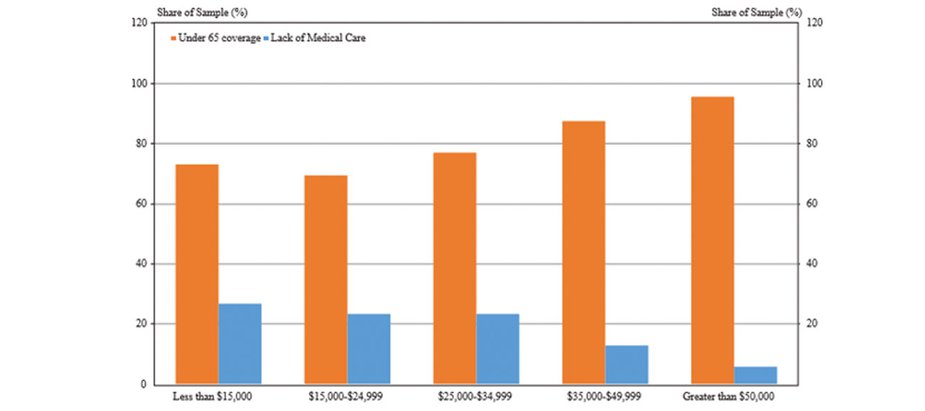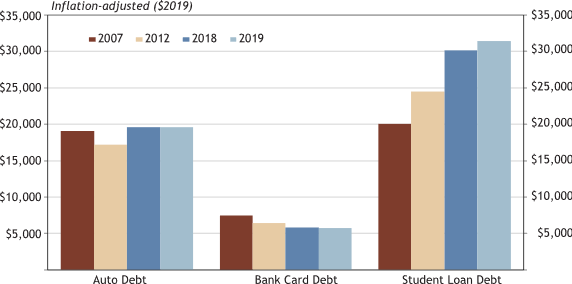A lack of health coverage and health care are major factors in why today’s booming economy is a bust for many. This is according to a July survey of people who work directly with low- and moderate-income (LMI) individuals. Respondents said there are plenty of jobs for LMI workers, but wages are stagnant and the jobs often lack benefits, particularly health insurance. Income and health was the special topic in the KC Fed LMI Economic Conditions report released in September.
The numbers tell the story. Compared with people with higher incomes, LMI people are much less likely to have health insurance and more likely to have chronic illnesses. For many, these are disabling conditions that prevent them from working.
Lower-income people have less coverage and care
Nearly 96 percent of people with incomes above $50,000 have some form of health insurance (Chart 1). For people with lower incomes the percentages drop. Of people younger than 65 and not eligible for Medicare, 73.2 percent of those with annual incomes of $15,000 have health insurance. The rate is 69.5 percent for those with annual incomes between $15,000 and $25,000.[i]
A study by the Centers for Disease Control and Prevention’s Behavioral Risk Factor Surveillance System (BRFSS) showed that people without coverage may forgo medical care because of cost.
Chart 1: Health insurance coverage and lack of medical care due to cost
Notes: Data are from the 2016 survey. Dollar figures refer to annual incomes. “Lack of Medical Care” means that at some time during the past year the respondent “needed” to see a doctor but did not because of cost.
Sources: Centers for Disease Control and Prevention, BRFSS.

More income and better health are linked
Unsurprisingly, lower-income people are more likely to self-report specific health problems or overall fair or poor health (Chart 2). The BRFSS survey asks respondents to rate their general health as excellent, very good, good, fair or poor. About 30 percent of people with incomes less than $15,000 said they were in fair or poor health, as did 21.3 percent for those with incomes between $15,000 and $25,000. Of people with incomes more than $50,000, though, only 5.4 percent said they were in fair or poor health.
Chart 2: Self-reported health status
Notes: Data are from the 2016 survey. Dollar figures refer to annual income.
Sources: Centers for Disease Control and Prevention, BRFSS.

Disabilities are more common among people with low incomes
The BRFSS study also found that the incidence of asthma, diabetes and depression is more than doubled for people with incomes less than $15,000 compared to those with incomes more than $50,000.
Having a disability can keep people from working. Social Security Administration data show that of those claiming a disability, 24.7 percent classified with depression or anxiety work, 27.1 percent with diabetes work and 29.4 percent with lung or respiratory problems work.[ii] In general, disabilities are more common among low-income people.
About the LMI Economic Conditions Index
The LMI Economic Conditions Index is the broadest measure of economic conditions in the LMI community. The KC Fed released the most recent LMI report in September 2018. The index rose significantly from 65.2 to 73.2, which indicates that fewer respondents think economic conditions are deteriorating relative to last year. The September index is based on the July LMI survey. A person, household or community is LMI if income is below 80 percent of area median income.
The Kansas City Fed sends the LMI survey twice a year to representatives of groups that directly provide services to LMI communities. Respondents answer questions about seven indicators. They report how the financial health of LMI constituents and their organization compares with the past quarter and past year. They also provide their expectations for the next quarter.
For more information
If you provide direct services to low- or moderate-income populations and would like to participate in the survey you can sign up here: https://www.kansascityfed.org/research/indicatorsdata/lmi/participate
For more information about income and health, and the economic conditions in the Tenth District: https://www.kansascityfed.org/research/indicatorsdata/lmieconomicconditions/articles/2018/lmi-economic-conditions-aug-2018
[i]Data from the Centers for Disease Control and Prevention’s Behavioral Risk Factor Surveillance System, which is a nationally representative survey. Data reported here are for 2016, the latest available.
[ii]U.S. Census Bureau, 2012, “Americans with Disabilities: 2010,” July. Available at External Linkhttps://www.census.gov/library/publications/2012/demo/p70-131.html
